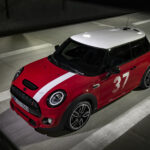The RR 310 has been around from December 2017 and since then many have been eargerly waiting for its naked avatar. Finally the RTR 310 was launched in September last year (2023) and it brings a fight to the 250-500cc, 30-50 HP street naked segment, but does it really have what it takes to challenge the undisputed king of the hill KTM Duke 390, now in its third generation and with an advantage of 11 HP?

Styling and Design
It has some very aggressive styling choices. The sharp bodywork sets this motorcycle apart from its peers. At the front it gets an LED headlight, which is a bit large and looks a little disproportionate. The fuel tank remains unchanged from the RR at 11 litres and here is flanked by sharp tank extensions on both sides. It also still uses the same chassis but now gets an aluminium sub-frame for the rear as compared to the steel trellis one on the RR. The RTR has an upswept rear end with a from the factory tail tidy, the number plate and indicators being integrated on the tyre hugger.

Seating and Ergonomics
It has fairly relaxed ergonomics wherein the rider is upright with a high and flat handlebar. The footpegs are slightly lower set than on the RR. Seat height stands at 800mm, which allows it to cater to both shorter and taller riders while also being a relatively easy motorcycle to maneuver even at crawling speeds due to its 169 Kg kerb weight. Overall the sitting posture is comfortable for both short city commutes and the occasional highway touring stint. As for ground clearance, it has got a healthy figure of 180mm; so deep potholes and high, sharp speed breakers will not be much of a problem here.

At its Heart
The familiar 312.2cc single cylinder motor is present here, but in a different state of tune with sprocketing changes. The mill puts out 35.6 HP at 9,700 rpm and 28.7 N-m of torque at 6,650 rpm, an increase of 1.6 HP and 1.4 N-m with peak torque arriving 1,050 rpm earlier. The RR uses a 17-42 teeth layout for the sprockets while here a 17-46 set-up has been used. With all these changes, the motor now has more low range pull and does so strongly till the redline.
It gets up to triple digit speeds quickly but the low gearing makes you feel the need to shift up even when in the sixth gear. To keep the ride experience a little less snappy in the city, switch to Urban or Rain mode where the power is reduced to 27.1 hp at 7,600 rpm and torque to 27.3 N-m at 6,600 rpm. Mild vibrations creep in at around 7,000 rpm and it is also where the engine starts feeling slightly stressed.
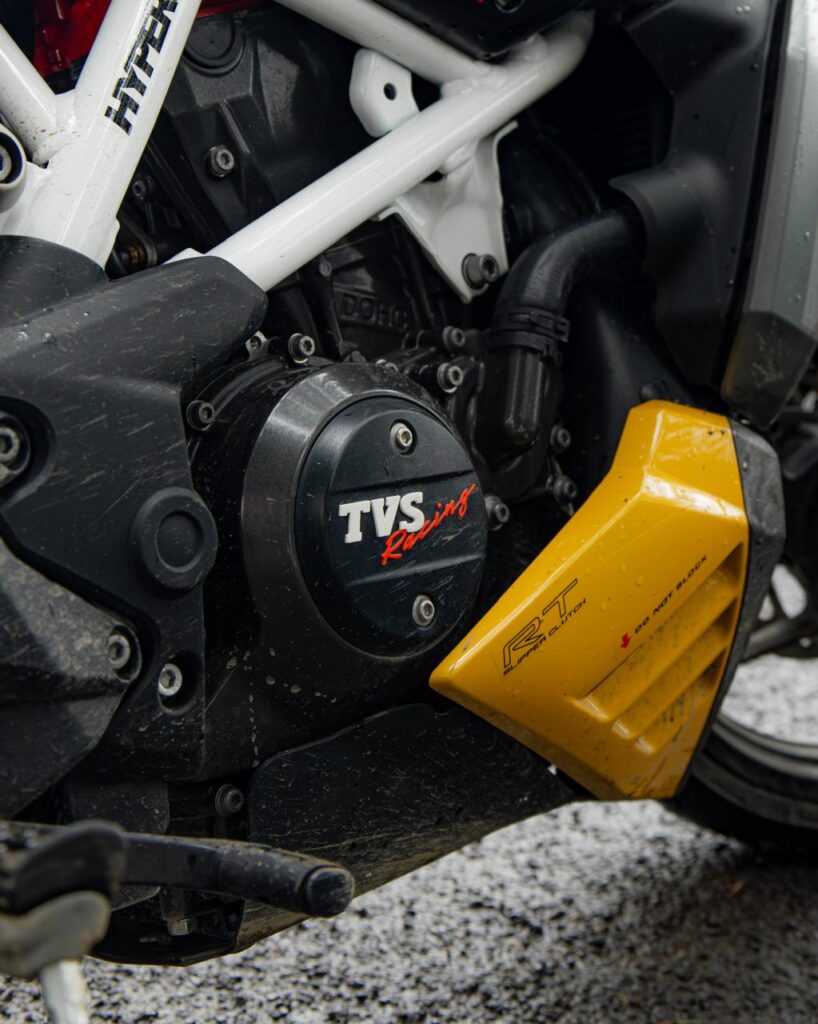
Tech Fest
On the features front, it gets a full colour Bluetooth enabled TFT screen with turn-by-turn navigation and race telemetry, which also offers different theme options dedicated to each of the five total riding modes: Rain, Urban, Sport, Track and Supermoto. In the latter three modes you have access to all the power and torque it has on offer, while in the Rain and Urban mode the performance is dialled down. Out on the road, the difference in performance is not huge but noticeable nonetheless.

Other features available from the Fury Yellow variant onwards include an assist and slipper clutch, a quick-shifter, traction control, cruise control, headlamp brightness adjustment and glide through technology (GTT). Also, as part of standard fitment, four step adjustable clutch and brake levers are on offer.
One of the main highlight features that had taken the internet by storm is the climate control seat that is on offer with the Dynamic Pro Kit. It works based on the ‘Peltier Effect’ and can vary the ambient temperature by ± 15° Celsius, but as a trade-off the seat is much harder and long hours in the saddle will be uncomfortable.
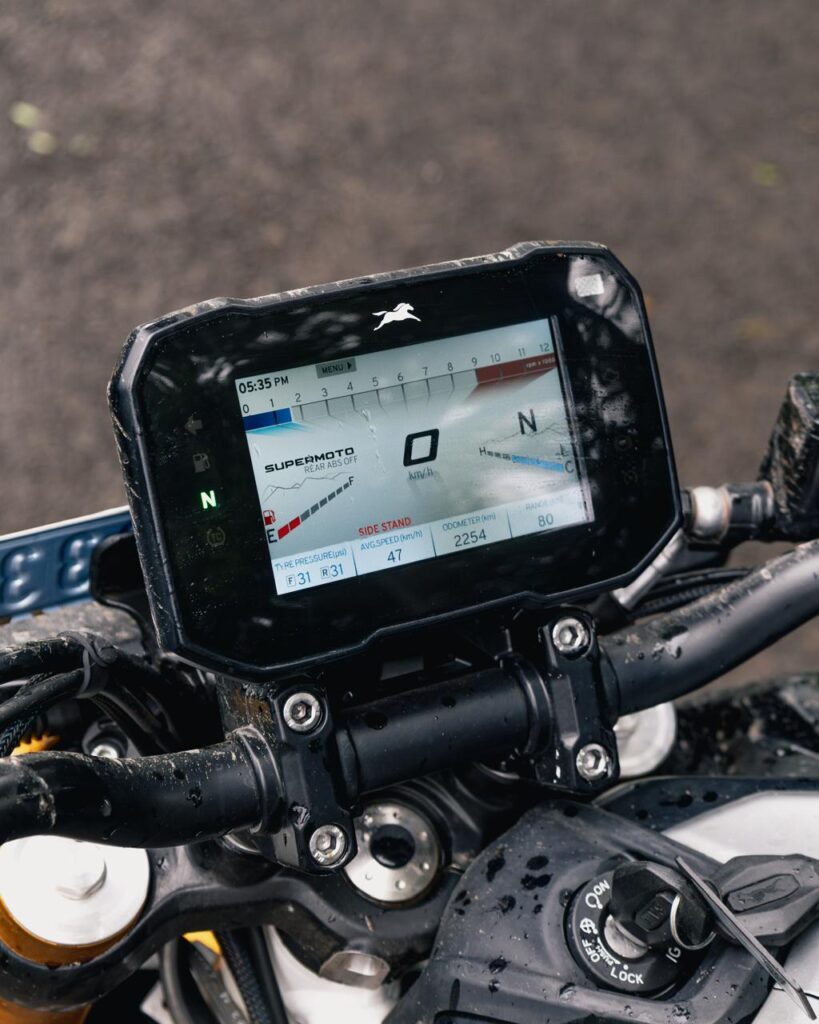
Smooth Operator
The left lever action is light with the shifts being slick by way of the slipper clutch and the quick-shifter is well calibrated too, making things easy for the rider. GTT comes very handy in the city by way of engine braking but feels slightly unnerving to use at first but the feeling goes away quickly once you get used to it and you will seriously thank TVS for the inclusion of this much needed feature in places with high traffic density; also ditto for the cruise control which works accurately, making highway rides a sublime affair.
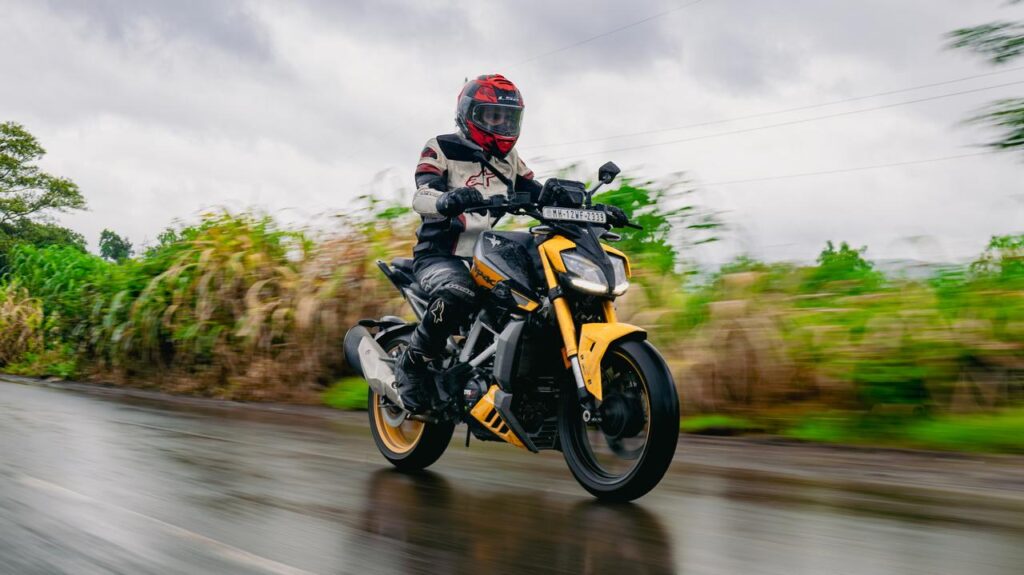
Suspension, Handling and Braking
The suspension setup comprises 41mm USD forks at the front and a preload adjustable mono-shock at the rear. It provides a plush ride quality, can take on our roads easily and handles very well due to a capable chassis and the ever amazing Michelin Road 5 tyres. The riding position is the only limitation as it is not aggressive enough.
In the braking department, the bike has 300mm front and 240mm rear discs. The front brake lever feel is sharp and it has a good bite; the rear brakes could have been better. ABS is well judged and the rear ABS can be switched-off in super-moto mode. Rear

Add-on Kits
There is a BTO (Built To Order) platform and customers can opt from a total of three packages:
- ‘Dynamic Kit‘ priced at ₹18,000 which includes fully adjustable front and rear suspension, tyre pressure monitoring system (TPMS) and a brass coated chain.
- ‘Dynamic Pro‘ at ₹22,000 and includes a six axis IMU based stability control, dynamic stability control (DSC) which is essentially cornering ABS, cornering traction control, wheelie control, rear wheel lift control (RLC/RLP), slope dependent brake control and a climate control seat with cooling-heating functionality.
- Finally, the ‘colour kit‘ that includes the Sepang Blue paint scheme which pays homage to 40 years of TVS Racing and costs ₹10,000.
All these three packs can be purchased either together or separately.

The not so Good
The motor can do better in some areas, throttle response is accurate while accelerating but deceleration happens with an abrupt jerk. The main talking point though are the vibrations, there is a prominent buzz from 5,000 rpm that increases linearly with revs, is noticeable at 90 km/h and gets more intense at 100 km/h. All said and done, the vibes are not absolutely frustrating, at least not for a few minutes.
The other main gripe here is its exhaust muffler, it is the same one as seen on the RR, which looks outdated and out of place on an otherwise sleek looking bike while also not sounding as good as its competition; wish the manufacturer had updated this. Also, the rear brake foot pedal lacks feel, feedback, bite and is not confidence inspiring.

Our Thoughts and Pricing
Overall the RTR 310 is a capable machine with quick acceleration, a plush ride, good build quality and a bunch of customization options. However, the engines’ nature might not suit everyone and the vibrations could be a major bother for those looking at frequent highway usage. The bike kind of feels made for stunt riders straight out of the factory due to how easily it gets that front wheel up, a slight change to sprocket sizes would make it more friendly for everyday use.
As for pricing, it starts at ₹2.43 Lakh for the base bike with no quick-shifter and the Arsenal Black colorway, but can go all the way up to ₹3.14 Lakh for a motorcycle equipped with all the three optional BTO packs (all prices ex-showroom).
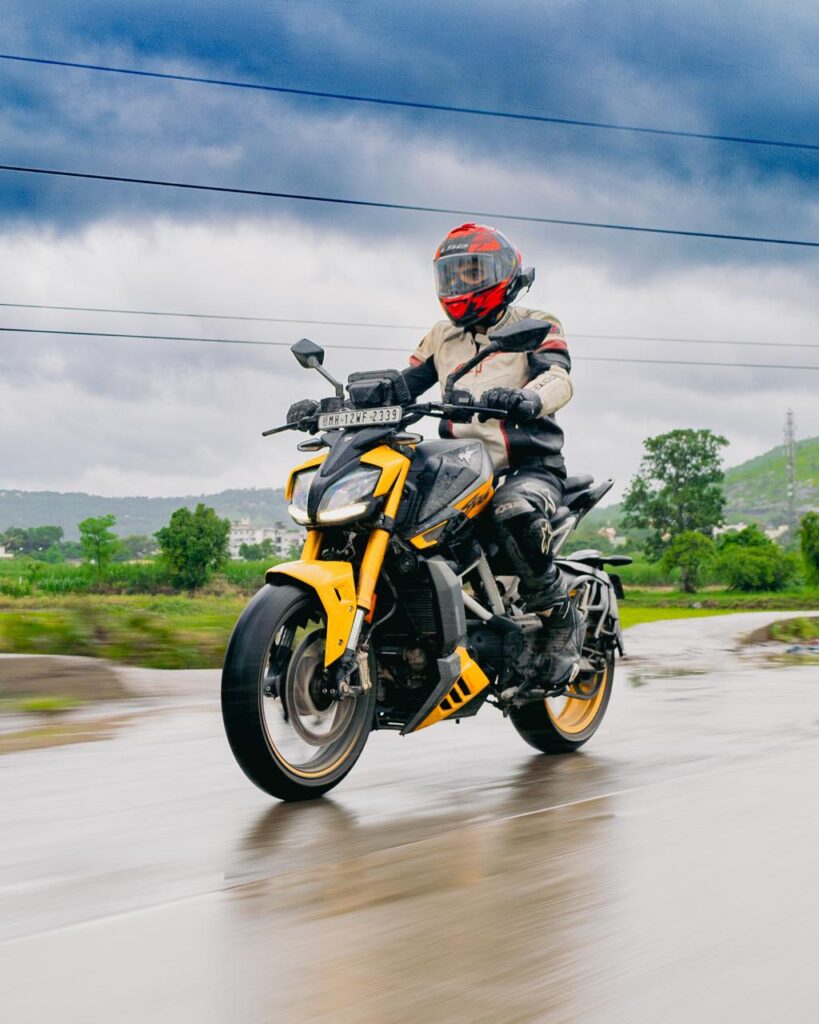
Specifications at a Glance
| Displacement | 312.2 cc |
| Engine | Single Cylinder, Reverse Inclined, Liquid Cooled, DOHC |
| Power | 35.6 HP @ 9,700 rpm (Sport, Track) 27.1 HP @ 7,600 rpm (Rain, Urban) |
| Torque | 28.7 N-m @ 6,650 rpm (Sport, Track) 27.3 N-m @ 6,600 rpm (Rain, Urban) |
| Gearbox | 6-speed with bi-directional QuickShifter (Q/S) |
| Sprockets | Front: 17 teeth, Rear: 46 teeth |
| Chassis | Trellis mainframe and Aluminium sub-frame |
| Suspension | Front: 41 mm USD, Rear: Monoshock |
| Riding Modes | Rain, Urban, Sport, Track |
| Ground Clearance | 183 mm |
| Fuel Tank Capacity | 11 litres |
| Kerb Weight | 169 kg |
| Tyres | Michelin Road 5; Front: 110/70-R17, Rear: 150/60-R17 |
| Brakes | Front: 300 mm, Rear: 220 mm; both Petal Discs |
| Seat Height | 800 mm |
| Pricing | ₹2.43-3.14 Lakh |







